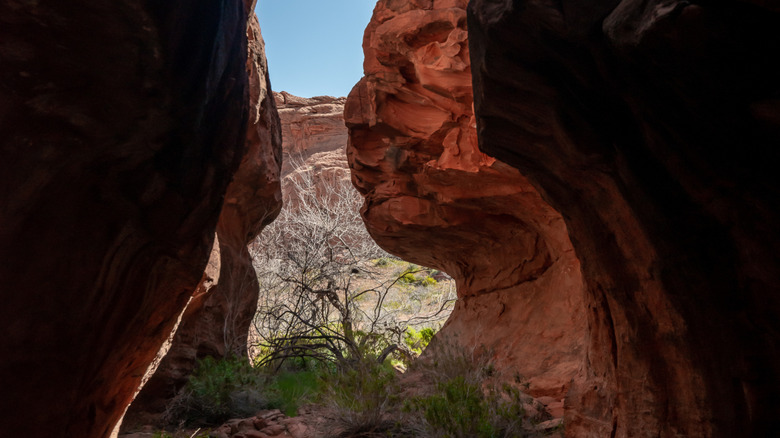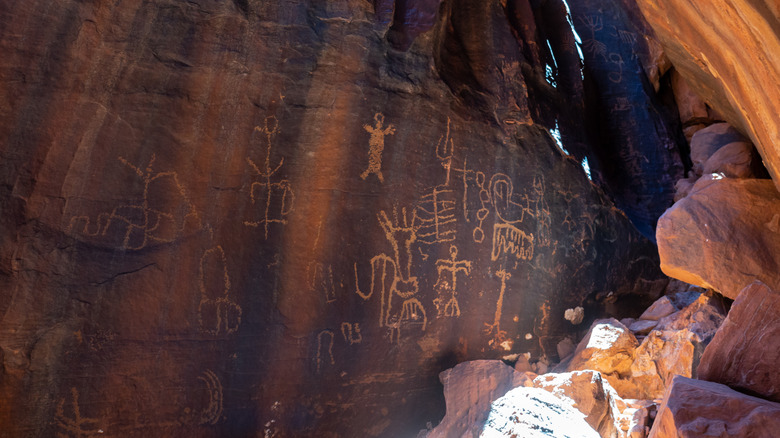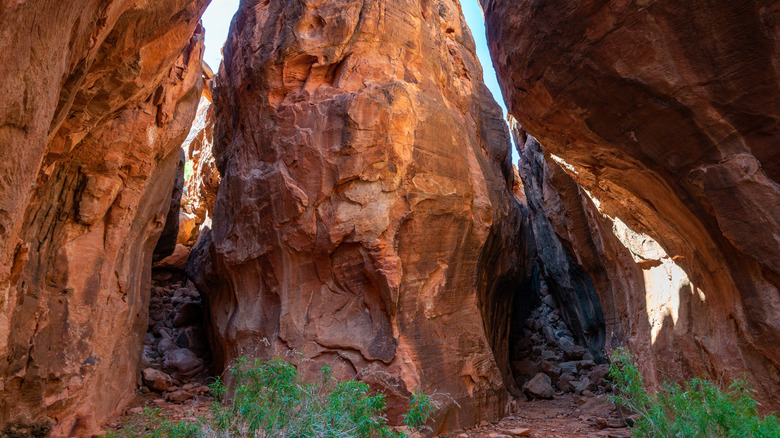One Of Nevada's Most Unusual Slot Canyons Is A Uniquely Shaped, Colorful Gem Full Of Ancient Rock Art
The American Southwest's slot canyons are among its most breathtaking geological wonders. Carved by the persistent forces of wind and water, these narrow passageways display an otherworldly beauty, with smooth, sculpted walls and rich hues. Some of the most well-known include California's awe-inspiring Painted Canyon and the striking sandstone formations of Arizona's Waterholes Canyon. But one canyon that can't be missed on a tour of the region's incredible geology is Seven Keyholes Canyon — not only for its distinctive keyhole-like formations but also for something you won't find in many others: ancient rock art.
Located in the remote stretches of Nevada's Mojave Desert, Seven Keyholes Canyon is a short but steep hike through a surreal Aztec sandstone landscape. The canyon's smooth, rounded hollows at its base taper upward into narrow crevices, resembling upside-down keyholes — a formation created over thousands of years by natural erosion. But what makes this place truly remarkable is the evidence of human history etched into its walls. Throughout the canyon, petroglyphs and pictographs left behind by Native Americans centuries ago tell silent stories of the past, turning this already spectacular landscape into an open-air museum of ancient artistry.
Unlock the hidden history of Seven Keyholes Canyon
Reaching Seven Keyholes Canyon requires a short hike from the roadside trailhead. The out-and-back route is just over a mile in total, with an elevation gain and loss of about 80 feet. Though not a strenuous trek, hikers will encounter a few challenges along the way, including a large boulder around halfway along the canyon that you have to climb over to continue through. As you make your way toward the upper end, you'll reach a dry waterfall where the trail comes to a natural conclusion.
One of the most striking features of the canyon walls is a phenomenon known as desert varnish — a dark, sometimes orange or black coating that forms over centuries due to the presence of clay minerals, manganese, and iron. This varnish serves as the perfect canvas for petroglyphs, which were created by ancient inhabitants chipping away at the surface to reveal the lighter rock beneath. These markings, along with more faint pictographs painted with natural pigments, indicate that Seven Keyholes was a significant place for the region's native people. The canyon likely provided water, shade, and shelter from the harsh desert elements.
If you want to scope out the rock art, one of the best places to look is near the mouth of the canyon, where several well-preserved petroglyphs can be found in the varnish. Among the large boulders scattered around the canyon, you may also come across pictographs, though they have faded over time. A particularly fascinating feature to watch for is the presence of cupules — small, circular indents carved into rock surfaces. These markings are believed to have served ceremonial purposes.
How to get to Seven Keyholes Canyon and what to know
Seven Keyholes Canyon is located within Gold Butte National Monument, a striking desert area full of red rocks and petroglyphs. The nearest major airport is Harry Reid International Airport in Las Vegas. From there, travelers will need to drive north for two hours toward Whitney Pocket, a popular base for those venturing into the remote backcountry. The journey then follows the Gold Butte Scenic Byway, a rugged but visually stunning route through the national monument. Keep an eye out for an intersection where a primitive road veers slightly to the left — this leads directly to the trailhead.
Because of its remote location, it's important to come prepared. Bring plenty of water, as desert temperatures can soar, and wear sturdy hiking shoes for navigating the uneven terrain. If you want a closer look at some of the higher-up petroglyphs, a pair of binoculars can be handy. While exploring, avoid touching or climbing on the rock art — natural oils from human skin can degrade these ancient markings. And as with any desert hike, be mindful of wildlife, including rattlesnakes, which may be hiding in the shade.


